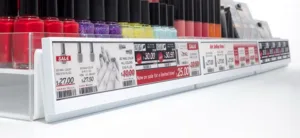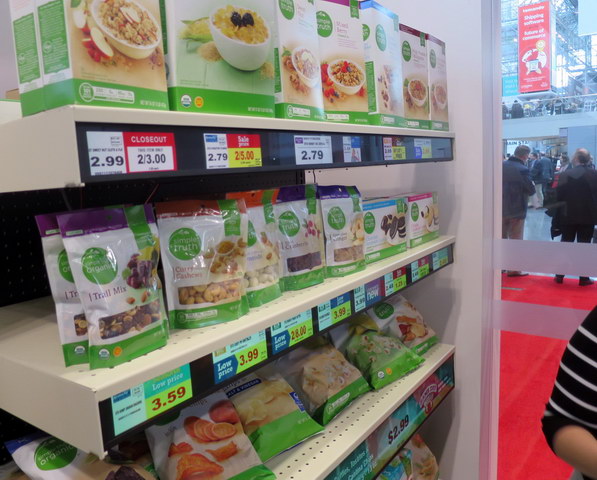 Two 2” and one 4” (at bottom) Edge displays at the NRF (Credit: M. Brennesholtz)
Two 2” and one 4” (at bottom) Edge displays at the NRF (Credit: M. Brennesholtz)
Edge R&D holdings, LLC was showing an interesting variation on electronic shelf edge labels (ESLs) (previously reported by us at SID in 2016 Projection Advancements). Most ESLs are based on e-paper or other very low power systems, allowing them to have multi-year battery life. The Edge system is based on rear projection, a much more power intensive system. The system uses a custom-designed LCoS chip as its image source. Specifications for the system are in the table. This design allows the Edge system to show not just prices and other information, but full motion, attention-getting video. The Edge system, unlike most other ESLs, showed images in full color. ESLs based on e-paper technology are either black and white or have a very limited color range.
The Edge system is currently installed in 17 Kroger stores, a US grocery store chain, with 130 more planned for 2018. The Edge representative at the NRF said that Kroger owns all the IP behind the Edge system. When asked about the physical space taken up by the Edge system, he did not seem particularly concerned. He said that the displays, so far, have been deployed mostly on the end-caps of store aisles, although some regular shelves in Kroger stores have been equipped as well. The aisle end cap is the area in a grocery store where promotional items are most commonly placed and the attention-getting ability of full motion video is important. He did say that if a grocery store besides Kroger installed the system, they would most likely initially use them on the end caps.
Two videos describing the system are posted on the Edge website.
|
Specifications for the Edge Rear Projection System |
||
|
Specification |
Edge with 2” wide display panel |
Edge with 4” wide display panel |
|
Dimensions |
||
|
Shelf Size |
3.625” tall x 48” wide |
5.625” high x 48” wide |
|
Display size |
2” tall x 45.75” wide |
4” tall x 46.75” wide |
|
Depth |
Depth 20” (20.875” actual), 24” (24.875” actual), and 30” (30.75” actual) |
Depth 20” (20.875” actual), 24” (24.875” actual), and 30” (30.75” actual) |
|
Weight (Metal Shelves) |
20” @ 29 lbs., 24” @ 34.5 lbs, 30” @ 43 lbs. (Calculated) |
20” @ 32.5 lbs. |
|
Weight (Electrical enclosure) |
15 lbs. |
16.5 lbs. |
|
LCoS Projector Display |
||
|
Video Performance |
Unlimited length at 50FPS |
Unlimited length at 30FPS |
|
Content File formats |
Image: PNG & JPG Video: MP4 H.264 Audio MP4 AAC |
Image: PNG & JPG Video: MP4 H.264 Audio MP4 AAC |
|
Viewable resolution |
3650 x 150 pixels |
3650 x 300 pixels |
|
Interfaces |
||
|
Current |
Zigbee, Wi-Fi (classic and low energy) |
Zigbee, Wi-Fi (classic and low energy) |
|
Planned |
Bluetooth 4.1 + BLE, 3G/4G, NFC |
Bluetooth 4.1 + BLE, 3G/4G, NFC |
|
Additional Interfaces |
||
|
Power |
24V @ 1.2A |
24V @ 1.2A |
|
Requirements |
16GB |
16GB |
|
Storage |
512 MB |
512 MB |
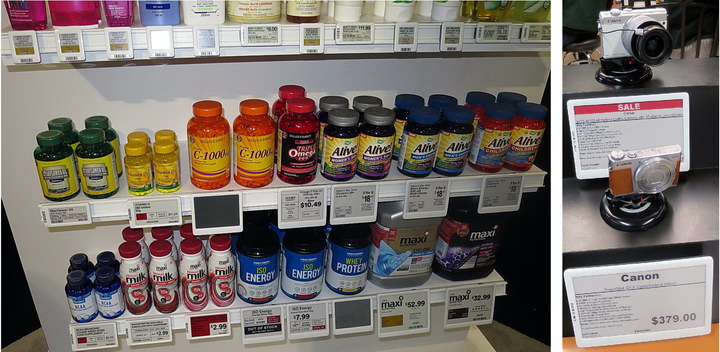 Left: a variety of ESLs in the Displaydata booth at NRF. Bottom shelf left to right is 3×3.7”, 3×4.0” and 2 x 6”. Right: Displaydata ESLs in use at the nearby B&H Superstore. (Credit: M. Brennesholtz)
Left: a variety of ESLs in the Displaydata booth at NRF. Bottom shelf left to right is 3×3.7”, 3×4.0” and 2 x 6”. Right: Displaydata ESLs in use at the nearby B&H Superstore. (Credit: M. Brennesholtz)
Displaydata was showing its electrophoretic display (EPD, commonly called e-paper) shelf edge labels. Thee labels which are available in sizes from 1.6” (40mm) to 12.5” (32cm) in diagonal. Paul Milner, the Displaydata rep I talked to, said there were two new sizes introduced at the NRF, 3.7” (94mm) and 12.5” (317mm). The 3.7” unit differed from the previous 4.0” (101mm) unit in that it had a wide 2:1 aspect ratio compared to the 1.7:1 aspect ratio of the 4” unit. The 12.5” unit is not really a “shelf edge label,” rather it is intended for display of product data as well as the price. Displaydata exhibited it between two cameras, showing the price and key information for both.
Displaydata has both black and white and three color ESLs. The three colors are either red/black/white or yellow/black/white. There is no mixing of colors and no gray scale – a given region is either red (or yellow), black or white. The company also offers a black and white label designed for in-freezer use that will operate down to -25°C (-13°F). Displaydata offers a Bluetooth Low Energy (BLE) option on some of its ESLs. This is not for updating the label. Rather, it is for communicating with a customers smartphone and downloading product data for the displayed item.
The labels are updated by a proprietary wireless system that uses a sub-1GHz RF band, which is not subject to interference from Wi-Fi or smartphones. Milner said a typical store would require only one of the transmitters, although a very large or multi-storey store might require two transmitters. All the labels in the booth, including the label Milner was wearing as a name tag, were being updated every two minutes to show booth visitors the update process. Milner said with an update of two to three times a day, the batteries in the ESLs would last about five years. Update is not, in fact, necessary unless something changes. The Displaydata ESLs, like any EPD, will hold its image indefinitely without power or updating. Each of the labels had a serial number, allowing the update process to send the correct price and other data to each ESL. Milner said this serial number was put on the ESL as a barcode, either on the front or the rear of the label, depending on the customer’s wishes.
Milner would not discuss the cost of the Displaydata ESLs. Instead, he talked about the total cost of ownership (TCO). He said that in a store where prices are changed frequently, electronic ESLs would pay for themselves, compared to paper ESLs, in as little as 2 – 3 months. With a less frequent price change schedule, it might take as long a year for the electronic ESLs to be more cost effective than paper. As an example of the actual use of Displaydata ESLs, Milner said that about 20,000 of them were in use in the nearby B&H Photo Video Superstore.
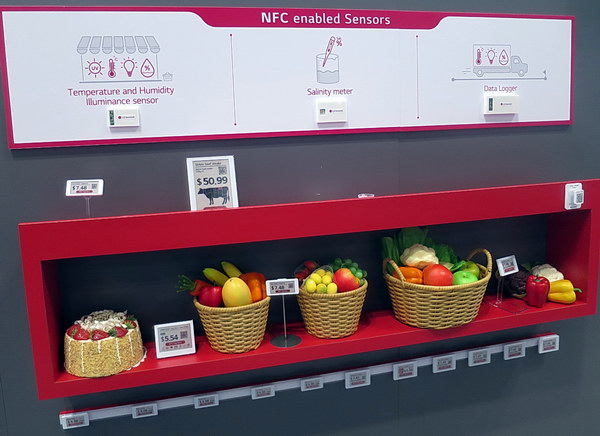 LG Innotek’s ESLs and other IoT products for retailers (Credit: M. Brennesholtz)
LG Innotek’s ESLs and other IoT products for retailers (Credit: M. Brennesholtz)
LG Innotek was at the NRF Big Show to talk about how its Internet of Things (IoT) products could help retailers. Most of what they had on display were ESLs but they also had other IoT items such as temperature, humidity and illuminance sensors, salinity sensors and data loggers. The LG Innotek ESLs were very similar to the ones from Displaydata. Available color combinations were the same: black/white, red/black/white and yellow/black/white. Sizes ranged from 1.5” (38mm) to 7.5” (190mm). One big difference from Displaydata was LG Innotek used the Zigbee communication protocol instead of a proprietary system. Zigbee also works in the sub-1GHZ RF band and is not subject to interference from Wi-Fi.
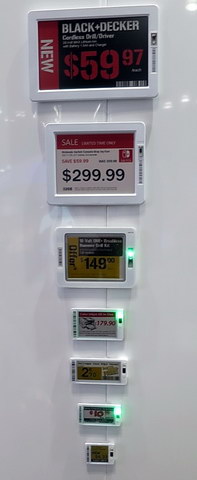 The SEL line-up from Pricer, some showing the flashing LED “on”. (Credit: M. Brennesholtz)
The SEL line-up from Pricer, some showing the flashing LED “on”. (Credit: M. Brennesholtz)
Pricer had ESLs much like the ones from Displaydata and LG Innotek. In particular, they were showing the same color combinations: black/white, red/black/white and yellow/black/white using E-Ink EPD materials. Some models of the Pricer ESLs include a green flashing LED that can be flashed on to call special attention to a particular product. (We have previously reported this feature being used by SES Imagotag with a camera system to allow the identification of replacement inkjet cartridges. Once the system identifies the part, the appropriate label will flash. This is helpful for customers, but also is faster and more accurate when staff are re-stocking. – Man. Ed. Retail Digital Signage Expo 2017 Round-Up)
One major difference between Pricer and the other companies is Pricer does not use RF to update it’s ESLs. Instead, it uses modulated IR light to do the update. The company said a single IR transmitter could cover roughly 150 m² of store area. A SEL did not need to be in line-of-sight of an IR transmitter – reflections off of the wall and floor were sufficient to update a SEL. According to Pricer, the IR approach has two advantages. First, no RF antenna is needed, allowing for more compact ESLs. Second, the IR system uses less power than RF so the battery in the SEL can last up to 10 years. According to the Pricer rep, their ESLs vary in price from $5 to $100, depending on size and model. Pricer has many big-name retail customers and they announced during NRF that Best Buy had just completed an initial 60 store installation of ESLs using Pricer products.
JDI 30cm wide SEL (Credit: JDI)
While JDI was not an exhibitor at the NRF Big Show, during the show they announced a 30cm wide by 4.2 cm high SEL module. This module has a resolution of 2242 × 335 and a pixel density of 198 ppi. JDI says that most retail store shelves are either 90cm or 120cm wide so either three or four modules will fill the complete shelf width. With this arrangement, multiple prices would be displayed on a single JDI module, as shown in the image. This SEL uses the red/black/white material from E-Ink, its strategic partner since November 2016. In addition to the 30cm module, the announcement discussed 7.5cm modules intended to price a single item. The announcement also said that the 30cm module would be displayed by JDI SEL customers at NRF but I didn’t see one. The announcement made no mention of JDI modules made from the yellow/black/white E-Ink material shown on ESLs from Displaydata, LG Innotek and Pricer.

